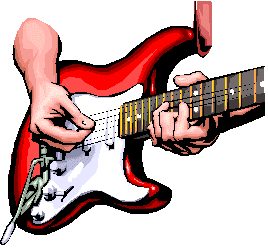The Downstroke


This symbol stands for a downstroke of the pick.
To play a downstroke place your pick on the top of a string. Pull downward to start the string vibrating. Do you hear the sound? Let your pick come to rest on the string below it. As you stroke, lightly rest your other fingers on the pick guard but do not “glue” them there. Let them move up and down with the movement of your hand.
While you are in position to play, look down at your guitar fingerboard. The top string is String Number 6. The others are 5, 4, 3, 2 and 1. Here is a diagram of your strings.

1. Start playing by stroking String Number 6. Come to a rest on String 5.
2. Stroke String 5. Rest on 4.
3. Stroke 4. Rest on 3.
Keep going up and down the strings until you are comfortable and can find the strings easily.
This is called playing the open strings.
See if you can play the following strings in the order they are written. Read them from left to right.
Notice that there are downstroke symbols over the string numbers. The “sim” following them tells you to keep playing the rest of the piece in a similar (or same) manner. This keeps your music from being too cluttered with symbols.
6
6 6 6 5 5 5 4 4 4
3 3 3 2 2 2 1 1 1
1 2 3 4 5 6 6 6 6
Throughout these lessons you will see the icon at the left. You can click on this icon to listen to an example of the piece. Remember that due to different sound fonts on your computer these pieces may not sound like your guitar. Six beats will play at the beginning of this piece to allow you time to pick up your guitar and play along if you would like. When these beats vary it will be noted next to the icon.
6
Now try playing this piece a little differently. Notice the dots after some of the string numbers? These mean to hold that sound a little longer. Listen to the piece being played to hear the difference then try it yourself.
6
6 6 6. 5 5 5. 4 4 4.
3 3 3. 2 2 2. 1 1 1.
1 2 3. 4 5 6. 6 6 6.
When you play several open strings in a row the sound begins to “mush” together. This is not always an appealing sound. You can remedy that by touching the strings with your left hand. Do this by gently closing your fingers around the strings until the sound is stopped. In the above exercise, try doing this at every dot. Your strings should sound a lot clearer.
|
|
|
|
|
|
|
|
|
|
|
|
|
|
|
|
Contact Us |
|
|
|
Site Design © Copyright by Nazarene Pages.com
Content © Copyright by J. Lynn Publishing
All Rights Reserved
All Lesson Materials
(c) Copyright 2005 by J. Lynn Publishing
All Rights Reserved
